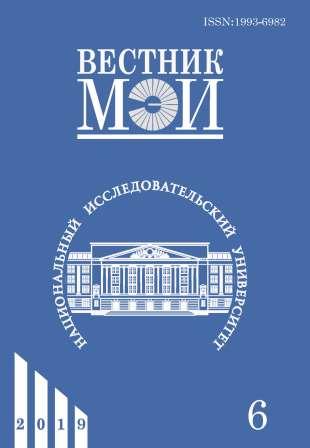Реакция модели здания со снижением жесткости на длиннопериодные сейсмические воздействия
DOI:
https://doi.org/10.24160/1993-6982-2019-6-124-130Ключевые слова:
длиннопериодное сейсмическое воздействие, акселерограммы, динамический анализ, гистерезис со снижением жесткостиАннотация
Длиннопериодные землетрясения с доминирующими периодами порядка 2…5 с возникают в дальней зоне воздействия и обычно имеют небольшую интенсивность. Они могут стать причиной разрушительных последствий для конструкций, если, во-первых, частоты воздействия близки к низшим собственным частотам конструкций, и, во-вторых, воздействия достаточно продолжительные. Цель работы заключается в моделировании ситуации, когда сейсмические колебания малой интенсивности действуют на конструкцию продолжительное время с частотами, близкими к резонансным. Это приводит к длительному колебательному процессу с большими амплитудами. При этом возможно циклическое упругопластическое деформирование системы с накоплением повреждений, деградацией жесткости и снижением собственных частот. Если во время длиннопериодного землетрясения преобладающие частоты воздействия также снижаются, то происходит «подстройка» конструкции под резонанс, усугубляющая последствия сейсмического воздействия.
Впервые проанализирована динамическая реакция системы со снижением жесткости на длиннопериодное сейсмическое воздействие с уменьшением несущей частоты. В качестве воздействия принята акселерограмма землетрясения Тохоку, записанная в Токио 11 марта 2011 г. на станции TKY017. Преобладающие частоты воздействия выбранной записи снижаются с 0,83 до 0,3 Гц. В ходе работы получены и проанализированы перемещения и их среднеквадратичные отклонения для систем с начальными собственными частотами 0,83; 1,0 и 0.5 Гц. Все вычисления, включая предварительную обработку сейсмического воздействия, реализацию алгоритма гистерезиса со снижением жесткости, интегрирование уравнений движения и анализ полученных результатов проведены в программном комплексе Matlab.
Библиографические ссылки
2. Lee W.H.K., Kanamori H., Jennings P., Kisslinger C. International Handbook of Earthquake and Engineering Seismology. Pt. B. N.-Y., London: Academic Press, 2003.
3. Çelebi M., Kashima T., Ghahari S. F., Abazarsa F., Taciroglu E. Responses of a Tall Building with US Сode-type Instrumentation in Tokyo, Japan — to Events Before, During and After the Tohoku Earthquake of March 11, 2011 // Earthquake Spectra. 2011. V. 32. Iss. 1. Pp. 497—522.
4. Позняк Е.В., Радин В.П., Новикова О.В. Частотно-временной анализ акселерограмм природных землетрясений // Вестник МЭИ. 2019. № 5. С. 135—141.
5. Campian C., Nagy Z., Pop M. Behavior of Fully Encased Steel-Concrete Composite Columns Subjected to Monotonic and Cyclic Loading // Proc. Intern. Sci. Conf. Urban Civil Eng. and Municipal Facilities. 2015. V. 117. Pp. 444—456.
6. Pimanmas A., Chaimahawan P. Cyclic Shear Resistance of Expanded Beam-Column Joint // Proc. Twelfth East Asia-Pacific Conf. Structural Eng. and Construction. 2011. V. 14. Pp. 1292—1299.
7. Bharti R., Chidambaram R.S., Kwatra N. Influence of Fiber Reinforced Concrete on Plastic Behavior on Exterior Beam Column Joint under Cyclic Loading // Proc. XI Intern. Symp. Plasticity and Impact Mechanics. 2017. V. 173. Pp. 1122—1129.
8. Nagel S., Knodel P., Ummenhofer T. Testing of Ultra-low Cycle Fatique at Complex Loading Scenarios // Procedia Structural Integrity. 2017. V. 5. Pp. 1377—1384.
9. Combescure C., Dumontet H., Voldoire F. Homogenised Constitutive Model Coupling Damage and Debonding for Reinforced Concrete Structures Under Cyclic Solicitations // Intern. J. Solids and Structures. 2013. V. 50. Pp. 3861—3874.
10. Zhoudao L.U., Lei S.U., Jiangtao Y.U. Experimental Study on the Seismic Behaviour of Strengthened Concrete Column-beam Joints by Simulated Earthquake // Procedia Eng. 2011. V. 14. Pp. 1871—1878.
11. Болотин В.В., Чирков В.П. Радин В.П., Трифонов О.В. Исследование упругопластического деформирования многоэтажного каркасного здания при интенсивных сейсмических воздействиях // Известия вузов. Серия «Строительство». 2001. № 5. С. 11—17.
12. Болотин В.В., Радин В.П., Чирков В.П. Исследование поведения зданий и сооружений со снижением жесткости при сейсмических воздействиях. Известия высших учебных заведений. Серия «Строительство». 2003. № 7 (535). С. 6—10.
---
Для цитирования: Радин В.П., Позняк Е.В., Новикова О.В. Реакция модели здания со снижением жесткости на длиннопериодные сейсмические воздействия // Вестник МЭИ. 2019. № 6. С. 124—130. DOI: 10.24160/1993-6982-2019-6-124-130.
#
1. Nazarov, Y., Travush V. Dlinnoperiodnye Seysmicheskie Vozdeystviya i Ikh Vliyanie na Prochnost' Konstruktsiy Vysotnykh Zdaniy. Intern. J. Computational Civil and Structural Eng. 2018;14:14—26. (in Russian).
2. Lee W.H.K., Kanamori H., Jennings P., Kisslinger C. International Handbook of Earthquake and Engineering Seismology. Pt. B. N.-Y., London: Academic Press, 2003.
3. Çelebi M., Kashima T., Ghahari S. F., Abazarsa F., Taciroglu E. Responses of a Tall Building with US Сode-type Instrumentation in Tokyo, Japan — to Events Before, During and After the Tohoku Earthquake of March 11, 2011. Earthquake Spectra. 2011;32;1:497—522.
4. Poznyak E.V., Radin V.P., Novikova O.V. Chastotno-vremennoy Analiz Akselerogramm Prirodnykh Zemletryaseniy. Vestnik MEI. 2019;5:135—141. (in Russian).
5. Campian C., Nagy Z., Pop M. Behavior of Fully Encased Steel-Concrete Composite Columns Subjected to Monotonic and Cyclic Loading. Proc. Intern. Sci. Conf. Urban Civil Eng. and Municipal Facilities. 2015;117: 444—456.
6. Pimanmas A., Chaimahawan P. Cyclic Shear Resistance of Expanded Beam-Column Joint. Proc. Twelfth East Asia-Pacific Conf. Structural Eng. and Construction. 2011;14:1292—1299.
7. Bharti R., Chidambaram R.S., Kwatra N. Influence of Fiber Reinforced Concrete on Plastic Behavior on Exterior Beam Column Joint under Cyclic Loading. Proc. XI Intern. Symp. Plasticity and Impact Mechanics. 2017;173:1122—1129.
8. Nagel S., Knodel P., Ummenhofer T. Testing of Ultra-low Cycle Fatique at Complex Loading Scenarios. Procedia Structural Integrity. 2017;5:1377—1384.
9. Combescure C., Dumontet H., Voldoire F. Homogenised Constitutive Model Coupling Damage and Debonding for Reinforced Concrete Structures Under Cyclic Solicitations. Intern. J. Solids and Structures. 2013; 50:3861—3874.
10. Zhoudao L.U., Lei S.U., Jiangtao Y.U. Experimental Study on the Seismic Behaviour of Strengthened Concrete Column-beam Joints by Simulated Earthquake. Procedia Eng. 2011;14:1871—1878.
11. Bolotin V.V., Chirkov V.P. Radin V.P., Trifonov O.V. Issledovanie Uprugoplasticheskogo Deformirovaniya Mnogoetazhnogo Karkasnogo Zdaniya pri Intensivnykh Seysmicheskikh Vozdeystviyakh. Izvestiya Vuzov. Seriya «Stroitel'stvo». 2001;5: 1—17. (in Russian).
12. Bolotin V.V., Radin V.P., Chirkov V.P. Issledovanie Povedeniya Zdaniy i Sooruzheniy so Snizheniem Zhestkosti pri Seysmicheskikh Vozdeystviyakh. Izvestiya Vysshikh Uchebnykh Zavedeniy. Seriya «Stroitel'stvo». 2003;7 (535):6—10. (in Russian).
---
For citation: Radin V.P., Poznyak E.V., Novikova O.V. The Dynamic Response of a Building Model with Decreasing Stiffness during Long-Period Earthquakes. Bulletin of MPEI. 2019;6:124—130. (in Russian). DOI: 10.24160/1993-6982-2019-6-124-130.




